2012 Week 5
At the completion of this week, we are halfway through the field season. The first five weeks seem to have gone by so fast and yet we have so much more to get done. As everyone already knows, this was the hottest week so far with temperatures above 95 on most afternoons. All we can do is try to work on units in the shade and keep drinking water. We needed to remove backfill from a unit over the Calvert House but the ground was so dry and hard that the shovels merely bounced off the surface.
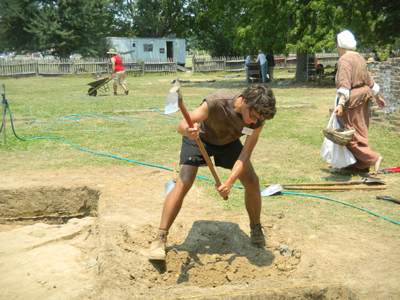
Chris Pasch breaks up the fill with a pickaxe..
It required a bigger tool to get the fill removed.
The search for fences was productive this week as we located 5 fence segments. All of these were parts of fences we already knew about but we were able to extend their known range. Particularly important was a fence on the western side of the site.
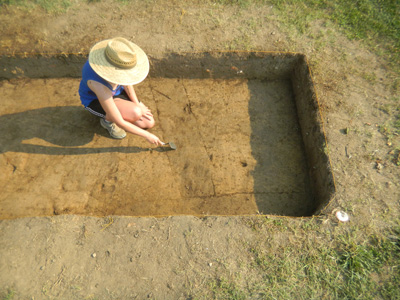
Marissa Parlock points to the fence line trench.
This fence was first seen along the southern edge of the site by a ravine. Over the past four years we have patiently followed this fence northward. It is a late period fence, perhaps dating to the 1680s, and represents the last formal definition of the Calvert House landscape.
One of the more interesting artifacts located in the testing of the Calvert House yards this week was a quartz projectile point.
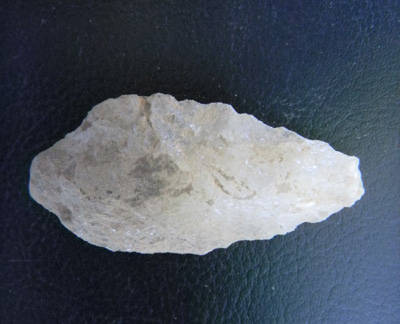
Middle Archaic projectile point (c. 5100-4500 BCE).
This type of point is termed a Morrow Mountain point and is associated with the Middle Archaic Period (5100 – 4500 B. C.). We often get asked why such older material would be found mixed with other materials in the plow zone. For the most part, Native Americans did not dig many deep features and when the land was plowed, their artifacts were mixed with everything else. Prehistoric artifacts are very common on the Calvert House site and, in fact, all over St. Mary’s City.
Another interesting artifact found this week was a blue and white glass bead.
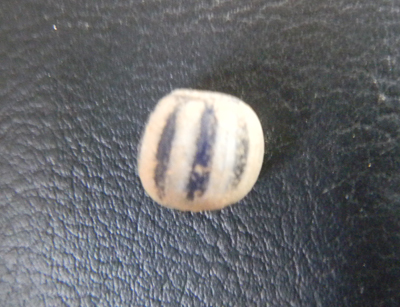
House foundation
Blue and white glass bead.
While these beads are not common, they are a regular find at the Calvert House. Made in Venice or possibly in Holland, each of these is a little piece of glass art. We often describe them as trade beads, recognizing that they were an important part of trade with the Native Americans. However, we should not ignore the fact that they were used by the colonists as well. They are much more common in the first half of the 17th century than later.
Work also continued in the Calvert House area.
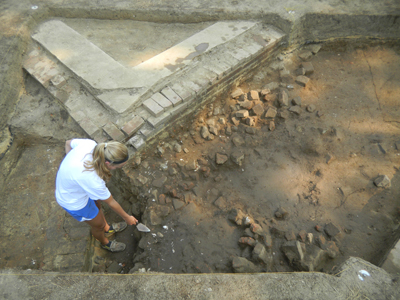
Carly Harmon cleans dirt from the brick rubble.
Last week we defined the interior edge of the brick-lined cellar. While this week was spent in exposing and cleaning the brick rubble which filled the top of the cellar. Also, we looked for the southern edge of the burned clay cellar. The unit we excavated did not come down on the bright red clay of the cellar wall but did expose an area densely filled with ash and charcoal. From previous excavations, we knew that such an ash concentration is typical of the uppermost fill of the cellar. Because of this, we will have to excavate the unit immediately south to seek the cellar wall.
I have commented several times that the final fill placed in and over the Calvert House was brought in from some other part of the site. Further confirmation of this process was found this week in the form of a large piece of lead-backed, tin glazed earthenware.
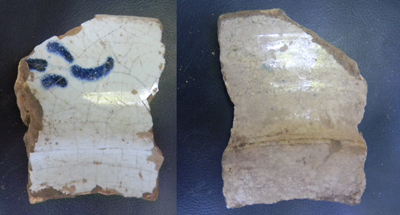
Both sides of the lead-backed, tin-glazed earthenware sherd
from the Calvert House area.
Tin glazed earthenware is made by mixing tin with the normal lead glaze to produce a white color. Early tin glaze has the tin only on the front side, which this fragment shows. The left side of the photo shows the front of the piece which is white with blue painted decoration. The right side of the photo shows the back of the piece which has no tin mixed with the glaze. Generally, such pieces date before 1670. The finding of this sherd in the fill above the rubble of the brick lined cellar, which could not have been filled in before the 18th century, is an indication of the nature of the filling process.


